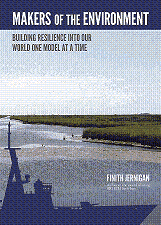Makers of the Environment
Written by Finith E Jernigan and Published by 4Site Press
Published by: 4Site Press
ISBN-13: 978-0979569968
430 Pages
December 21, 2011
Makers of the Environment is part of an information model whose foundation is a printed book. Some might call it a building information model, but book information model is probably more accurate. The goal is to represent the complexity and power of information modeling technologies and processes within what has up to now been a linear media. Today, information modeling is taking hold in the built environment, the man-made part of the world.
The built environment provides the setting for human activity; ranging from buildings to neighborhoods to cities, and including infrastructure, such as transportation, water and energy networks and other things that relate to humans over time. The ability to interact with everything in the built environment is the most compelling aspect of the information that surrounds us. Easily using the distributed, multidimensional tools and processes that connect data from multiple sources is not a dream… people are doing it today. Collaborative processes, rich data repositories and advanced graphics are the seeds of this information revolution. Properly applied, the tools that make this transformation possible are straightforward and accessible. Anyone can apply them to their benefit.
Nigel Davies, Director of United Kingdom Evolve Consultancy;says of the book: Finith’s approach to the highly dispersed subject of information management builds on the style he initiated in BIG BIM little bim, yet with in a much more ambitious context. His position is now firmly set as one of the foremost authors of modern information management techniques. His natural grasp of what is really important in Building Information Management (sic), and this work’s fictional approach to the enigma of design information management helps the reader understand the implications of action and inaction from the human perspective.
Instead of a work of dry technical theories, Finith manages to exemplify concepts clearly and with real application. Finith has a wealth of knowledge to share and shares it very well. In fact the “almost reality” style is so well written and so close to what we could, and should, be doing with our information models, that I was wondering if I’d missed out on some major changes in the industry. At least with this book, you’ll be in a strong position to play catch-up. For once a technical business book is worth adding to your night-time reading list.

